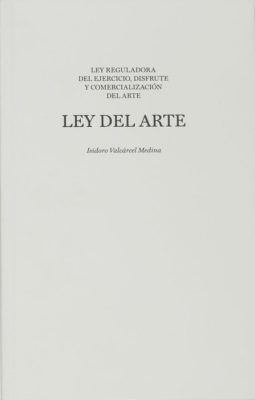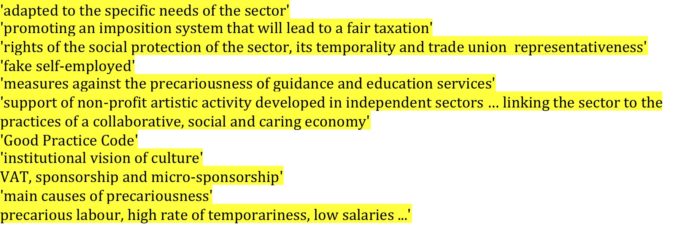Search
To search for an exact match, type the word or phrase you want in quotation marks.
A*DESK has been offering since 2002 contents about criticism and contemporary art. A*DESK has become consolidated thanks to all those who have believed in the project, all those who have followed us, debating, participating and collaborating. Many people have collaborated with A*DESK, and continue to do so. Their efforts, knowledge and belief in the project are what make it grow internationally. At A*DESK we have also generated work for over one hundred professionals in culture, from small collaborations with reviews and classes, to more prolonged and intense collaborations.
At A*DESK we believe in the need for free and universal access to culture and knowledge. We want to carry on being independent, remaining open to more ideas and opinions. If you believe in A*DESK, we need your backing to be able to continue. You can now participate in the project by supporting it. You can choose how much you want to contribute to the project.
You can decide how much you want to bring to the project.

The ‘Report of the Subcommittee for the Elaboration of a Statute of the Artist’ appears on fifteen double pages. I sat at the table to read it, highlighting the key ideas with a yellow fluorescent felt pen.
The first part indicates that reality is being updated:
 The most tangible reality we have for the visual arts sector are the data compiled in the second edition of La actividad económica de los/las artistas en Españaby Marta Pérez Ibáñez and Isidro López-Aparicio, a study that estimates the number of artists working in Spain at approximately 25,000 artists.
The most tangible reality we have for the visual arts sector are the data compiled in the second edition of La actividad económica de los/las artistas en Españaby Marta Pérez Ibáñez and Isidro López-Aparicio, a study that estimates the number of artists working in Spain at approximately 25,000 artists.
I summoned my most tangible reality – a network of affections, experiences and common interests – through the social media, and launched the question:
‘How many of you have read the statute?’
CHIRP CHIRP CHIRP (silence in the night, only the chirrup of a cricket is heard)
CHIRP CHIRP CHIRP (isn’t it the voice of the cricket hitting the wooden head?)
(To read the Statute, click here)
Only two affirmative answers … many ‘I hadn’t even heard of it’ and references to artists’ associations in some regions (caution: in their study, Pérez Ibáñez and López-Aparicio emphasise the fact that 40% of artists have never formed a part of any kind of association).
The associative fact appears as a paradox within the community of visual artists. We must bear in mind that other activities studied in the report – film or drama, for instance – have a structural framework that includes even a trade union, a possibility that hasn’t actually materialised in the sphere of the visual arts. Conceiving the sector as an industry is very different from conceiving it as an individual model, that still exists and is promoted from certain market areas.
The Statute is unprecedented and is born to change paradigms, and to a certain extent it succeeds in doing so. It defines the cultural fact as an indispensable collective good for society. It doesn’t forget that creation requires a previous and continuous task by artists and the entire network of professionals with whom they work. It is therefore an activity set in the public sphere, hence some of the problems we can identify in the Spanish visual arts scene that, as a collectivity, is scarcely organised (the attempts to create trade unions in the nineties disappeared with the crisis) and has no spirit of solidarity over and above what is strictly private. I’m thinking of a model like the German Kunstvereins that articulate common interests and material supports among artists, programmers, context, sponsors and politicians.
The other aspect that appears as paradigmatic in the study is the recognition of culture as labour and the attempt to update its present conditions of production. Temporality and precariousness would be the two prominent features of artistic activity, and most of the recommended measures as regards taxation and social protection are aimed at reducing them.
Then another doubt arises. The text recognises the vocational element in all artistic practices, their immateriality and, as I mentioned earlier, the social value of their formalisation. The will of the artist, or of the cultural worker, is described as irremediable. In other words, it will prevail regardless of material conditions because it has connotations of vital commitment. At a time when the analyses of cognitive capitalism point to the extension of work activity as a continuum – people are always working – this precariousness and temporality become / will become a constant, and the specific proposals of regulation would only seem to mitigate contributive differences in relation to other activities. They only concern the framework of economised life. And they should move beyond that. To quote the German collective kpD, ‘In the last two hundred years, those who have been affected time and again by precariousness are those who have positioned themselves as ‘Others’ with respect to the white, male national hegemonic norm. Precariousness isn’t only an economic affair, which is why we take it as a base from which to conceive the fundamental constitution of our Western societies. Our starting point is precariousness as a way of building society, a point from which we try to understand the conditions of subjectification associated with precariousness …’.[1]
The idea is to mitigate precariousness, although this is understood as an intrinsic element in the artist’s way of life. It would seem as if we hadn’t succeeded in leaving behind the model of bohemia, that of the exceptional genius, but also that of the madman, the child, of those who remain outside the system of citizenship. In order to adapt to this system, the artist also becomes a producer of himself, as exemplified by Menger’s positivistic conception in France,[2]or Groys’s critical vision.[3]To this we add what I would call the ‘evil of nobility’ (inspired by one of the characters in El Lazarillo de Tormes, the feeling of coming from a higher class where speaking of money is frowned upon, even if people live in poverty) that to a great extent in the sphere of the visual arts makes us understand one another and establish a distance with regard to the rest of society. We can’t speak of Romanticism starting from these clichés because even our degree of commitment would be affected. We complain, we discuss our conditions of production but we don’t use the democratic mechanisms that exist to propose changes nor do we revolutionise the streets.
Perhaps other forms of political action should reformulate the concept of labour, labour relations, the meaning of culture and the artistic fact as a situation for generating critical thought. Artistic creation should be linked to a notion of perception that calls its surroundings into question, from outside the rule, and the rule could simply be the widespread point of view or the constructed sense of perspective. The critical paradigm would then be how to regulate what is created under the slogan of irregularity?
Cover image: Isidoro Valcárcel Medina, La Ley del Arte: Ley Reguladora del Ejercicio, Disfrute y Comercialización del Arte. This essay was presented by the artist as a popular initiative before the Spanish parliament. The text began, ‘Reasons for the project. The Spanish legal system lacks a satisfactory approach – indeed, broadly speaking, even a modest approach – to what is a key element in individual and collective evolution and development: art.’ On 20 October 1992, the parliament chamber denied the motion. In 2010, Sala Parpalló, managed by Valencia Provincial Government, published a book edited by Belén Gopegui under the title El arte en cuestión / La Ley del Arte, with texts by Rogelio López Cuenca and Daniel G. Andújar.
[1]kdP, ‘La precarización de los productores y productoras culturales y la ausente “vida buena”,’ Transversal, 06/2005. http://eipcp.net/transversal/0406/kpd/es(last accessed 29.11.18).
[2]Pierre-Michel Menger, ‘L’art analysé comme un travail’, Idées économiques et sociales, 2009/4 No. 158, pp. 23-29.
[3]Boris Groys, Volverse público. Las transformaciones del arte en el ágora contemporánea, Caja Negra Editora, Buenos Aires, 2014.

Marta Ramos-Yzquierdo is used to change and adaptation. That is why she has has worked in the most diverse fields within the art world and the cultural management. She has lived in Paris, Granada, Madrid, Santiago de Chile, a lot of years in Sao Paulo and now in Barcelona. She talks a lot with artists and other beings to seek for many questions, especially about power structures, perception and ways of acting, feeling and living.
"A desk is a dangerous place from which to watch the world" (John Le Carré)